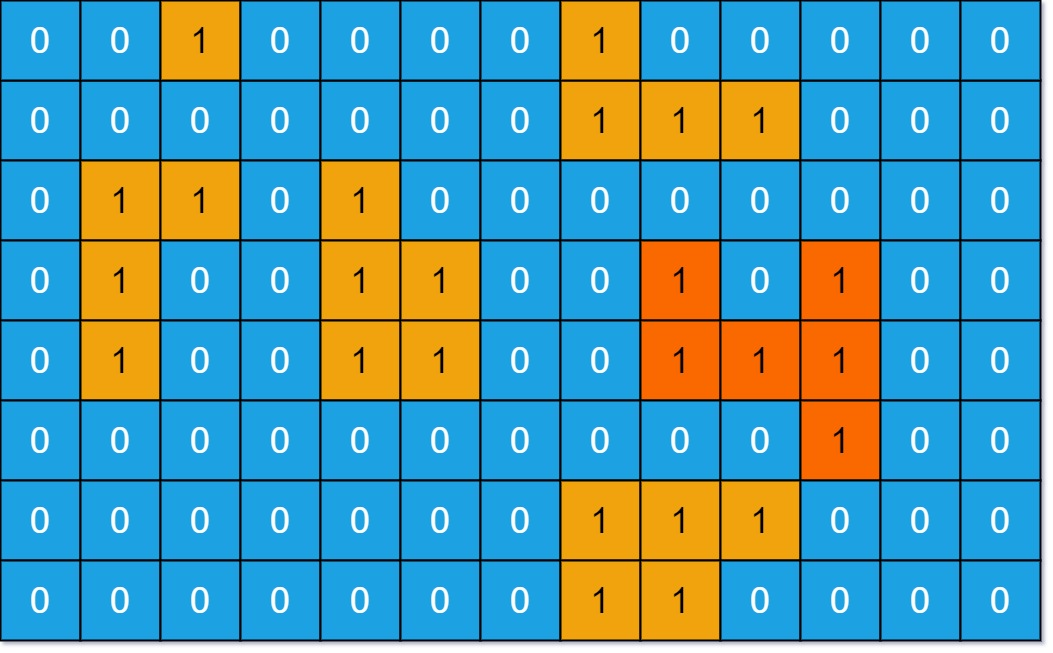You are given an m x n binary matrix grid. An island is a group of 1's (representing land) connected 4-directionally (horizontal or vertical.) You may assume all four edges of the grid are surrounded by water.
The area of an island is the number of cells with a value 1 in the island.
Return the maximum area of an island in grid. If there is no island, return 0.
Input: grid = [[0,0,1,0,0,0,0,1,0,0,0,0,0],[0,0,0,0,0,0,0,1,1,1,0,0,0],[0,1,1,0,1,0,0,0,0,0,0,0,0],[0,1,0,0,1,1,0,0,1,0,1,0,0],[0,1,0,0,1,1,0,0,1,1,1,0,0],[0,0,0,0,0,0,0,0,0,0,1,0,0],[0,0,0,0,0,0,0,1,1,1,0,0,0],[0,0,0,0,0,0,0,1,1,0,0,0,0]] Output: 6 Explanation: The answer is not 11, because the island must be connected 4-directionally.
Input: grid = [[0,0,0,0,0,0,0,0]] Output: 0
m == grid.lengthn == grid[i].length1 <= m, n <= 50grid[i][j]is either0or1.
# @param {Integer[][]} grid
# @return {Integer}
def max_area_of_island(grid)
m = grid.size
n = grid[0].size
ret = 0
(0...m).each do |i|
(0...n).each do |j|
next if grid[i][j] == 0
area = 0
cells = [[i, j]]
until cells.empty?
i, j = cells.pop
next if grid[i][j] == 0
area += 1
grid[i][j] = 0
cells.push([i - 1, j]) if i > 0 && grid[i - 1][j] == 1
cells.push([i + 1, j]) if i < m - 1 && grid[i + 1][j] == 1
cells.push([i, j - 1]) if j > 0 && grid[i][j - 1] == 1
cells.push([i, j + 1]) if j < n - 1 && grid[i][j + 1] == 1
end
ret = [ret, area].max
end
end
ret
endimpl Solution {
pub fn max_area_of_island(mut grid: Vec<Vec<i32>>) -> i32 {
let m = grid.len();
let n = grid[0].len();
let mut ret = 0;
for i in 0..m {
for j in 0..n {
if grid[i][j] == 0 {
continue;
}
let mut area = 0;
let mut cells = vec![(i, j)];
while let Some((i, j)) = cells.pop() {
if grid[i][j] == 0 {
continue;
}
area += 1;
grid[i][j] = 0;
if i > 0 && grid[i - 1][j] == 1 {
cells.push((i - 1, j));
}
if i < m - 1 && grid[i + 1][j] == 1 {
cells.push((i + 1, j));
}
if j > 0 && grid[i][j - 1] == 1 {
cells.push((i, j - 1));
}
if j < n - 1 && grid[i][j + 1] == 1 {
cells.push((i, j + 1));
}
}
ret = ret.max(area);
}
}
ret
}
}